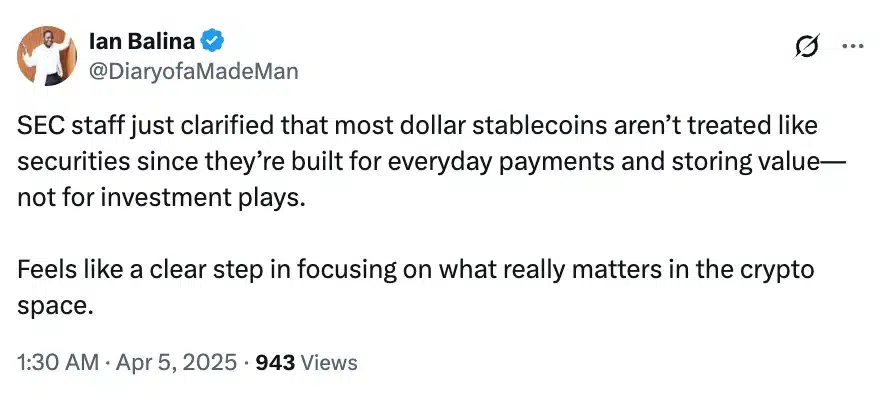-
The financial landscape is shifting as the SEC faces backlash over its stablecoin guidelines amid rising transaction volumes.
-
The criticism toward the SEC’s framework highlights ongoing debates regarding regulation and stability in the crypto market.
-
The SEC’s actions have sparked dialogue within the crypto community, revealing differing perspectives on regulatory clarity.
An analysis of the SEC’s stablecoin guidelines reveals a contentious debate among regulators and the crypto community amid a booming market.
Caroline Crenshaw slams SEC’s stablecoin guidelines
U.S. SEC Commissioner Caroline Crenshaw has publicly rebuked the agency’s recent guidelines concerning stablecoins, characterizing them as fundamentally flawed. Her statement criticized the SEC’s portrayal of vulnerabilities within the USD-backed stablecoin sector, suggesting a careless disregard for critical risks associated with these financial instruments.
She expressed concern that the updated framework, which designates some stablecoins as “non-securities” with reduced reporting obligations, overly simplifies the associated risks. This view challenges the SEC’s optimism about the effectiveness of mechanisms aimed at risk mitigation.
For instance, the SEC articulated that, “Some USD-stablecoins are available to retail purchasers only through an intermediary and not directly from the issuer.” Contrarily, Crenshaw argued that this assertion inadequately reflects the reality, asserting, “It is the general rule, not the exception, that these coins are available to the retail public only through intermediaries who sell them on the secondary market, such as crypto trading platforms.”
She emphasized this point by disclosing that “Over 90% of USD-stablecoins in circulation are distributed in this way,” illustrating a critical disconnect between the agency’s stance and market practices.
Mixed reaction from the crypto community
The response among stakeholders in the crypto community has been mixed. Some have applauded the SEC’s more explicit international posture towards stablecoins. For example, Token Metrics founder Ian Ballina praised it as a noteworthy move towards addressing pressing issues.

Source: Ian Balina/X
In contrast, Vemanti CEO Tan Tran noted a missed opportunity for earlier clarity, remarking, “Thank you for the clarification, @SECGov. Wish you had arrived at this same conclusion 3 years earlier…No matter, better late than never. We’re working on relaunching the @Vemanti $VMNT USDV stablecoin.”
Moreover, Ian Kane from Midnight Network viewed the developments as a positive step for compliant crypto enthusiasts, stating, “Overall, this feels like progress for crypto folks trying to play by the rules. Is this complete regulatory clarity? Nope. It’s a signal. If you’re building stable, transparent, and boring-in-a-good-way financial tools, there may be a compliant path forward.”
Nonetheless, Crenshaw remained critical of the SEC’s assumptions regarding issuers and their redemption capabilities, branding it “grossly inaccurate” to presume that financial stability could be gauged solely through asset reserves. She elaborated, stating, “The issuer’s overall financial health and solvency cannot be judged by the value of its reserve, which tells us nothing about its liabilities, risk from proprietary financial activities, and so forth.”
Stablecoin market current condition
Crenshaw’s remarks emerge at a critical juncture for the stablecoin market, which is experiencing heightened scrutiny. Recent reports indicate that Tether has enlisted a prestigious accounting firm to audit its asset reserves, aiming to ensure that its USDT stablecoin maintains a consistent 1:1 backing.
Coinciding with this, total transaction volumes for stablecoins surged to $670.22 billion in March, with USDT standing at the helm, followed closely by USDC, as noted by Visa’s on-chain analytics.
In a parallel legislative development, the U.S. House Financial Services Committee recently passed the Republican-backed STABLE Act with a 32-17 vote on April 2. This legislative action illustrates the growing urgency for comprehensive oversight and robust accountability measures within the stablecoin market.
Conclusion
The recent controversies surrounding the SEC’s stablecoin guidelines underscore significant challenges in cryptocurrency regulation. As the stablecoin market evolves, regulatory clarity becomes increasingly vital. Stakeholders must navigate these complexities while advocating for responsible innovation in the thriving digital asset landscape, ensuring robust measures are put in place to protect investors and maintain market integrity.
